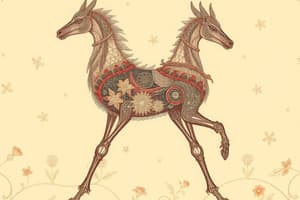Podcast
Questions and Answers
Which factor does NOT contribute to internal forces during locomotion?
Which factor does NOT contribute to internal forces during locomotion?
- Friction between surfaces
- Ground reaction forces (correct)
- Body weight
- Muscle contractions
What is the primary purpose of converting potential energy to kinetic energy during the stance phase?
What is the primary purpose of converting potential energy to kinetic energy during the stance phase?
- To generate forward momentum (correct)
- To support the body's weight
- To enhance muscle activation
- To maintain balance
During the swing phase of walking, which statement is true about the mechanical energy utilized?
During the swing phase of walking, which statement is true about the mechanical energy utilized?
- Kinetic energy cannot be used during this phase.
- Muscles are primarily activated to maintain leg movement.
- Potential energy is minimized to conserve energy.
- Mechanical energy reduces the need for muscle activation. (correct)
At what point in the gait cycle is the axis of rotation transferred from the ankle to the hip?
At what point in the gait cycle is the axis of rotation transferred from the ankle to the hip?
Which equation represents the calculation of potential energy near Earth's gravity?
Which equation represents the calculation of potential energy near Earth's gravity?
In the context of gait analysis, what is the significance of the Centre of Pressure?
In the context of gait analysis, what is the significance of the Centre of Pressure?
What description best suits the mechanics of the swing phase in locomotion?
What description best suits the mechanics of the swing phase in locomotion?
How does the distribution of ground reaction force during walking benefit the body?
How does the distribution of ground reaction force during walking benefit the body?
Which statement accurately describes the relationship between body weight and internal forces during locomotion?
Which statement accurately describes the relationship between body weight and internal forces during locomotion?
What characterizes the first half of the loading response phase in gait?
What characterizes the first half of the loading response phase in gait?
What role does the forward momentum of the body play during the rising phase of the stance in walking?
What role does the forward momentum of the body play during the rising phase of the stance in walking?
Which of the following best describes the energy transformation occurring during the swing phase of walking?
Which of the following best describes the energy transformation occurring during the swing phase of walking?
How does the length of the pendulum (leg) affect human gait?
How does the length of the pendulum (leg) affect human gait?
What does the Centre of Pressure signify in the context of gait analysis?
What does the Centre of Pressure signify in the context of gait analysis?
What is the significance of ground reaction forces during the stance phase of walking?
What is the significance of ground reaction forces during the stance phase of walking?
Which equation correctly represents kinetic energy for a non-rotating mass?
Which equation correctly represents kinetic energy for a non-rotating mass?
In what way does distributing ground reaction force influence injury risk during walking?
In what way does distributing ground reaction force influence injury risk during walking?
What happens to potential energy as the body's limbs advance during the stance phase?
What happens to potential energy as the body's limbs advance during the stance phase?
Which factor primarily influences the efficiency of weight transfer during gait?
Which factor primarily influences the efficiency of weight transfer during gait?
How does potential energy relate to the falling phase of the swing in walking?
How does potential energy relate to the falling phase of the swing in walking?
Flashcards are hidden until you start studying
Study Notes
Kinetics of Gait
- External Forces include gravity, friction, and ground reaction forces.
- Internal Forces include muscle forces and friction.
Stance Phase Modeled as an Inverted Pendulum
- Forward momentum of the body provides angular rotation for rising phase of stance.
- Potential energy is transformed into kinetic energy during the falling phase.
- At toe-off, the axis of rotation is transferred from the ankle to the hip.
Swing Phase Modeled as a Conventional Pendulum
- Swing phase involves legs moving as conventional pendulums.
- Use of mechanical energy reduces the need for muscle activation.
- Potential energy at toe-off is converted to kinetic energy during the falling phase.
- The inverse occurs during the rising phase.
- Pendulum (leg) length accounts for the "natural" frequency of human gait.
Ground Reaction Forces
- Ground reaction forces are the forces exerted by the ground on the body during walking.
- They vary throughout the gait cycle, being greatest during the stance phase, specifically during the loading response and mid-stance.
- Ground reaction force is directly proportional to the body weight and the acceleration of the body.
Distributing Ground Reaction Force
- Pressure is defined as Force/Area.
- Distributing force across a larger area reduces the likelihood of injury.
- The Centre of Pressure (COP) is the centre of the resultant forces.
- The path of the COP can reflect the efficiency of weight transfer and indicate potential for excessive tissue loading during gait.
Mechanical Power during Walking
- Mechanical power is the rate at which work is done.
- It is calculated as the product of moment (torque) and angular velocity.
- During walking, mechanical power is generated by the muscles to produce movement.
- The pattern of mechanical power output varies throughout the gait cycle, with high power output required during the stance phase for propulsion.
Neural Control of Locomotion
- The neural control of locomotion involves complex interactions between the central nervous system and the musculoskeletal system.
- The central pattern generator (CPG) is believed to be a network of neurons in the spinal cord that generates the basic rhythmic pattern of locomotion.
- The CPG receives input from sensory receptors in the limbs and other parts of the body, and it also receives input from higher brain centers that can modulate and modify the locomotor pattern.
- This allows for flexibility and adaptation to changing conditions.
Replicating Human Gait
- Replicating human gait in machines is a complex challenge that involves understanding the biomechanics of walking and developing technologies that can mimic the human body's movements.
- This has applications in areas such as prosthetic limb development, robotics, and virtual reality.
Kinetics of Gait
- External forces include gravity, friction, and ground reaction forces
- Internal forces include muscles and friction
- Forward momentum of the body provides angular rotation for the rising phase of stance
- Potential energy is transformed into kinetic energy during the falling phase
- The axis of rotation is transferred from the ankle to the hip at toe-off
- Potential energy, in the context of Earth's gravity, is calculated by $E_p$ (J) = mass (kg) x gravitational acceleration (m/s/s) x height (m)
- Kinetic energy, for a non-rotating mass, is calculated by $E_k$ (J) = ½ x mass (kg) x velocity (m/s)²
Stance Phase
- Modeled as an inverted pendulum
- At toe-off, potential energy is converted to kinetic energy
Swing Phase
- Modeled as a conventional pendulum
- Leg movement is actuated by mechanical energy, reducing muscle activation
- Potential energy at toe-off converts to kinetic energy during the falling phase
- Inverse occurs during the rising phase
- "Natural" frequency of gait is influenced by leg length
Ground Reaction Forces
- Pressure is calculated as Force/Area
- Pressure distribution reduces the risk of injury
- Centre of Pressure represents the central point of resultant forces
- The Centre of Pressure's path reflects weight transfer efficiency and potential for excessive tissue loading
- There are different ground reaction forces during the phases of walking
Mechanical Power in Walking
- Mechanical power = Moment x Angular velocity
Studying That Suits You
Use AI to generate personalized quizzes and flashcards to suit your learning preferences.



